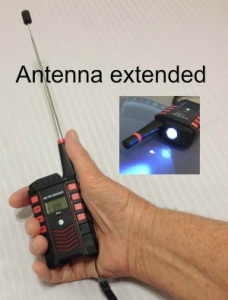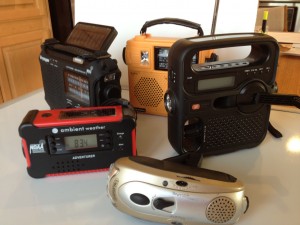Hand-Held Survival Tool
We have spent a lot of time talking about the various emergency radio choices that are available — solar/crank-powered for receiving emergency communications, and hand-held walkie-talkies for keeping in touch. We even did a video about workplace communications — you’ll see the link below this post.
But when you’re caught on the road . . .
But, it’s clear that we need to address the reality that few people caught on the road or away from home will be carrying their solar/crank-powered emergency radio with them — and their walkie-talkies won’t do them much good, either, since those are limited in range.
If you stay in the car, you’ll probably be able to get emergency news and weather reports on your car radio. But if you have no radio,
Or if you have to start walking . . .
You need a reliable alternative.
 The only one we have found that is consistently reliable, affordable and the right size is the Ambient Weather WR-090 Emergency Pocket AM/FM/WB Weather Alert Radio with Digital Tuner and Flashlight
The only one we have found that is consistently reliable, affordable and the right size is the Ambient Weather WR-090 Emergency Pocket AM/FM/WB Weather Alert Radio with Digital Tuner and Flashlight
You can gauge the size of the radio by seeing it in the photo, in my hand. In the photo, the antenna is fully extended; when you store it, of course, you’ll retract it into its 2-inch antenna stub (shorter than my thumb).
When you select the weather band mode, there’s a red LED ALERT feature (right under the screen), and a clearly marked button on the side turns on a reasonable built-in flashlight. (Photo insert)
This powerful gem is powered by three replaceable, AAA batteries. It only weighs 4 ounces (including the batteries) and
Easily fits into a pocket, purse or glove compartment of the car.
Most alkaline batteries have a shelf life of ten years. We recommend, however, that the batteries be changed at least once a year, depending on the frequency of usage and exposure of the unit to excessive heat, etc.
As with any battery-powered electronic device, you always want to have extra, fresh, replacement batteries on hand. We prefer the premium Duracell Quantum or Energizer equivalent high-density core. These premium batteries deliver full power longer than the standard models. When you’re dealing with emergency-related devices, you want the best quality, most dependable power available.
(Store extra batteries in your Commuter Kit. )
We personally have three of these units, one for each of our two cars and one for the kitchen drawer. You’ll feel better if you have a couple of them handy, too. Here’s the direct link to the radio at Amazon, which is where we get ours.
Joe Krueger
Emergency Plan Guide
If you’re interested in radios, here are three more resources:
- For communications at work, check out our Resilient Business Video #2: http://youtu.be/_x1JFTjfOCg
- Radio Reviews
- Radio Reviews, Updated

